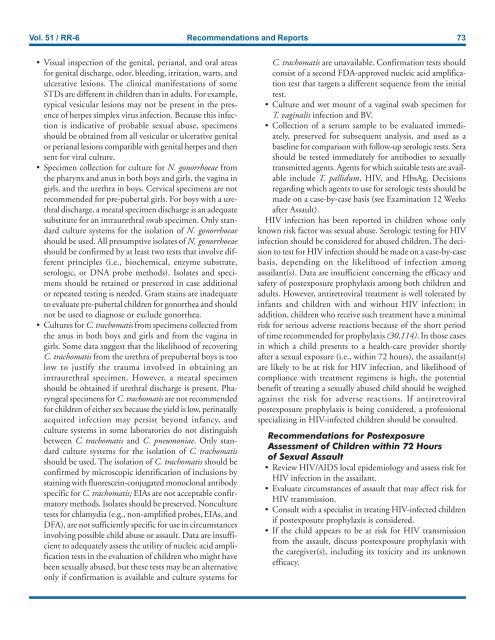Create successful ePaper yourself
Turn your PDF publications into a flip-book with our unique Google optimized e-Paper software.
Vol. 51 / RR-6 Recommendations and Reports 73<br />
Visual inspection of the genital, perianal, and oral areas<br />
for genital discharge, odor, bleeding, irritation, warts, and<br />
ulcerative lesions. The clinical manifestations of some<br />
STDs are different in children than in adults. For example,<br />
typical vesicular lesions may not be present in the presence<br />
of herpes simplex virus infection. Because this infection<br />
is indicative of probable sexual abuse, specimens<br />
should be obtained from all vesicular or ulcerative genital<br />
or perianal lesions compatible with genital herpes and then<br />
sent for viral culture.<br />
Specimen collection for culture for N. gonorrhoeae from<br />
the pharynx and anus in both boys and girls, the vagina in<br />
girls, and the urethra in boys. Cervical specimens are not<br />
recommended for pre-pubertal girls. For boys with a urethral<br />
discharge, a meatal specimen discharge is an adequate<br />
substitute for an intraurethral swab specimen. O<strong>nl</strong>y standard<br />
culture systems for the isolation of N. gonorrhoeae<br />
should be used. All presumptive isolates of N. gonorrhoeae<br />
should be confirmed by at least two tests that involve different<br />
principles (i.e., biochemical, enzyme substrate,<br />
serologic, or DNA probe methods). Isolates and specimens<br />
should be retained or preserved in case additional<br />
or repeated testing is needed. Gram stains are inadequate<br />
to evaluate pre-pubertal children for gonorrhea and should<br />
not be used to diagnose or exclude gonorrhea.<br />
Cultures for C. trachomatis from specimens collected from<br />
the anus in both boys and girls and from the vagina in<br />
girls. Some data suggest that the likelihood of recovering<br />
C. trachomatis from the urethra of prepubertal boys is too<br />
low to justify the trauma involved in obtaining an<br />
intraurethral specimen. However, a meatal specimen<br />
should be obtained if urethral discharge is present. Pharyngeal<br />
specimens for C. trachomatis are not recommended<br />
for children of either sex because the yield is low, perinatally<br />
acquired infection may persist beyond infancy, and<br />
culture systems in some laboratories do not distinguish<br />
between C. trachomatis and C. pneumoniae. O<strong>nl</strong>y standard<br />
culture systems for the isolation of C. trachomatis<br />
should be used. The isolation of C. trachomatis should be<br />
confirmed by microscopic identification of inclusions by<br />
staining with fluorescein-conjugated monoclonal antibody<br />
specific for C. trachomatis; EIAs are not acceptable confirmatory<br />
methods. Isolates should be preserved. Nonculture<br />
tests for chlamydia (e.g., non-amplified probes, EIAs, and<br />
DFA), are not sufficiently specific for use in circumstances<br />
involving possible child abuse or assault. Data are insufficient<br />
to adequately assess the utility of nucleic acid amplification<br />
tests in the evaluation of children who might have<br />
been sexually abused, but these tests may be an alternative<br />
o<strong>nl</strong>y if confirmation is available and culture systems for<br />
C. trachomatis are unavailable. Confirmation tests should<br />
consist of a second FDA-approved nucleic acid amplification<br />
test that targets a different sequence from the initial<br />
test.<br />
Culture and wet mount of a vaginal swab specimen for<br />
T. vaginalis infection and BV.<br />
Collection of a serum sample to be evaluated immediately,<br />
preserved for subsequent analysis, and used as a<br />
baseline for comparison with follow-up serologic tests. Sera<br />
should be tested immediately for antibodies to sexually<br />
transmitted agents. Agents for which suitable tests are available<br />
include T. pallidum, HIV, and HbsAg. Decisions<br />
regarding which agents to use for serologic tests should be<br />
made on a case-by-case basis (see Examination 12 Weeks<br />
after Assault).<br />
HIV infection has been reported in children whose o<strong>nl</strong>y<br />
known risk factor was sexual abuse. Serologic testing for HIV<br />
infection should be considered for abused children. The decision<br />
to test for HIV infection should be made on a case-by-case<br />
basis, depending on the likelihood of infection among<br />
assailant(s). Data are insufficient concerning the efficacy and<br />
safety of postexposure prophylaxis among both children and<br />
adults. However, antiretroviral treatment is well tolerated by<br />
infants and children with and without HIV infection; in<br />
addition, children who receive such treatment have a minimal<br />
risk for serious adverse reactions because of the short period<br />
of time recommended for prophylaxis (30,114). In those cases<br />
in which a child presents to a health-care provider shortly<br />
after a sexual exposure (i.e., within 72 hours), the assailant(s)<br />
are likely to be at risk for HIV infection, and likelihood of<br />
compliance with treatment regimens is high, the potential<br />
benefit of treating a sexually abused child should be weighed<br />
against the risk for adverse reactions. If antiretroviral<br />
postexposure prophylaxis is being considered, a professional<br />
specializing in HIV-infected children should be consulted.<br />
Recommendations for Postexposure<br />
Assessment of Children within 72 Hours<br />
of Sexual Assault<br />
Review HIV/AIDS local epidemiology and assess risk for<br />
HIV infection in the assailant.<br />
Evaluate circumstances of assault that may affect risk for<br />
HIV transmission.<br />
Consult with a specialist in treating HIV-infected children<br />
if postexposure prophylaxis is considered.<br />
If the child appears to be at risk for HIV transmission<br />
from the assault, discuss postexposure prophylaxis with<br />
the caregiver(s), including its toxicity and its unknown<br />
efficacy.


